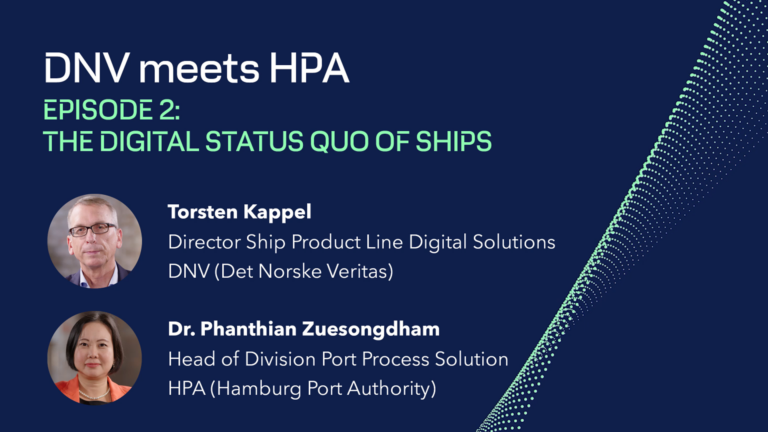




The maritime industry is undergoing rapid digitalization, transforming ship operations, port management, and the working environment for seafarers. Industry leaders Phanthian Zuesongdham (HPA) and Torsten Kappel (DNV) discuss key advancements, including real-time data integration, digital resilience, and cybersecurity challenges. The COVID-19 pandemic accelerated digital adoption, highlighting the need for robust communication tools and remote operational capabilities. While digital tools improve efficiency and working conditions, the industry must also strengthen cybersecurity measures and align with global digitalization initiatives like the Maritime Single Window. Looking ahead, collaboration and innovation will be essential in shaping a more connected and resilient maritime sector.
This article draws from an in-depth conversation with industry experts called "DNV meets HPA". In Episode 2, Torsten Kappel (DNV) and Dr. Phanthian Zuesongdham (HPA) uncover how COVID-19 tested the shipping industry’s resilience and accelerated the digital evolution. They dive deep into the rising importance of cyber defense and reveal the role of the Maritime Single Window for the future of shipping.
Phanthian Zuesongdham, Head of Port Process Solution at the Hamburg Port Authority (HPA), and Torsten Kappel, responsible for the Ship Product Line at DNV’s Digital Solutions business area, are two experts at the forefront of maritime digitalization. Their discussion sheds light on the evolution of digital technologies in shipping and ports, highlighting both achievements and challenges.
THE DIGITAL REVOLUTION IN SHIPPING
The shipping industry has undergone a significant transformation in recent years. As Torsten Kappel points out, the move from paper-based navigation to electronic charts, integrated navigation systems, and real-time weather forecasting has revolutionized vessel operations. Ships today are increasingly connected, with data from engines, bridges, and external sources feeding into a centralized digital ecosystem. This level of integration allows for improved visibility into operational performance and more efficient decision-making.
Yet, the perception of shipping in the public eye remains outdated. Many still associate it solely with fuel consumption, overlooking the fact that shipping is at the cutting edge of technology and digital innovation. According to Kappel, the COVID-19 pandemic played a pivotal role in shifting this perception, emphasizing the importance of digital tools for communication and remote operations. Unlike many industries that struggled with sudden remote work demands, the maritime sector was relatively well-prepared due to its longstanding need for global connectivity.

Shipping is technology, shipping is digital."

When the pandemic struck in 2020, concerns arose about the potential collapse of global supply chains. However, shipping proved to be one of the most resilient industries, ensuring the continuous movement of goods. Even unforeseen challenges, such as the Suez Canal blockage, tested but did not break the industry’s ability to adapt.
This resilience was made possible through digital preparedness. Ports and shipping companies had already established digital communication systems, allowing for seamless operations even in times of crisis. The industry’s ability to quickly respond and adapt showcased the power of digital transformation in maintaining stability.
Beyond operational efficiency, digitalization has also improved the working environment for seafarers. Crew comfort has become an increasing focus, with new technologies providing better communication tools and connectivity while at sea. The introduction of solutions like Starlink has accelerated the adoption of always-on connectivity, enabling better support for crew members and enhancing their daily lives onboard.




THE RISING THREAT OF CYBER-ATTACKS
With increased digitalization comes the challenge of cybersecurity. As ports and ships become more reliant on digital tools, they also become more vulnerable to cyber threats. Both Zuesongdham and Kappel stress that cybersecurity must be a collective effort within the industry. The reality is that no company – big or small – is immune from cyber risks.

As seen in past incidents, even major players have been targeted, underscoring the need for collaboration in sharing knowledge and strengthening defenses.
Kappel emphasizes that companies must move beyond reactive approaches and proactively integrate cybersecurity into their daily operations. Fighting cybercrime should not be a solitary effort; rather, it requires a united front from the entire maritime community.




MARITIME SINGLE WINDOW
The International Maritime Organization (IMO) has set ambitious digitalization goals to enhance efficiency in the industry. One key initiative is the implementation of Maritime Single Windows, aimed at simplifying ship-to-shore reporting processes. The port clearance software Navigator Port is an example of a digital tool that aligns with these goals, serving as a digital assistant for senior management onboard vessels. By reducing administrative burdens, such solutions allow crew members to focus on critical tasks such as vessel safety and performance optimization.
However, despite these advancements, there is still room for improvement. Both experts agree that while the Maritime Single Window initiative is a step forward, it is often utilized by agents rather than fully integrated into broader digital transformation strategies. To truly leverage its potential, the industry must push for greater adoption and enhancement of digital reporting frameworks.
CONCLUSION: THE FUTURE OF MARITIME DIGITALIZATION
The shipping and port industries have made significant strides in digital transformation, yet challenges remain. From cybersecurity risks to the need for wider adoption of digital reporting solutions, there is still work to be done. However, as evidenced by the resilience shown during the pandemic and the rapid pace of technological advancements, the future of maritime digitalization is promising.
By embracing collaboration, investing in cybersecurity, and continuing to innovate, the industry can build a more efficient, secure, and connected global shipping network. With leaders like Zuesongdham and Kappel guiding the way, the path toward a fully digital maritime sector is clearer than ever.
we navigate the change."
